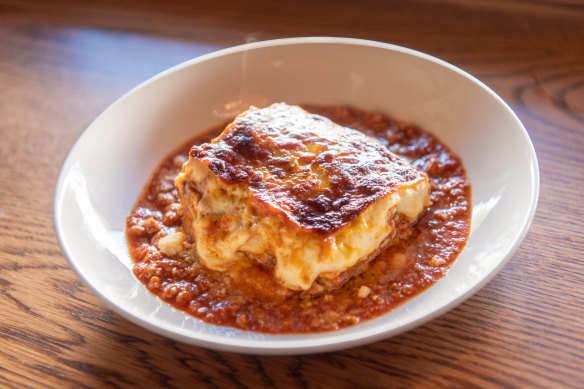This was published 10 months ago
Hats are back as Good Food steps up its dining coverage in Western Australia
A national system for recognising and rewarding exceptional restaurants, the return of the hat ranking system is all about helping diners eat better. It’s just one of the new changes Good Food is bringing to the west coast’s fast-moving food scene.
In 1979, the first edition of The Age Good Food Guide was published. Edited by German-born political- correspondent-turned-food-critic Claude Forell, the Guide provided a snapshot of Victoria’s new dining scene: ties and jackets were non-negotiable for gents dining in certain establishments; French cuisine reigned; and sushi was described as “vinegared rice hors d’oeuvres”.
That maiden Guide also introduced eaters to “hats”, a ranking system used to distinguish restaurants that were a cut above and delivered in terms of cooking, service and ambience. Some observers describe hats as Australia’s equivalent of Michelin stars, not least because both systems use one, two and three hats (or stars) to rank venues. It’s a fair comparison.

WA restaurants will be able to score “hats” again.Credit: Good Food Guide
But when you consider that there are just seven three-hatted restaurants (the top ranking in the Good Food hats system) across the entire country – three in New South Wales; three in Victoria; plus one in South Australia – one gets a sense of the level that these top restaurants need to operate at. (By comparison, the infamous Michelin inspectors have anointed 12 three-stars in Tokyo, nine in Paris, and five in London.)
Five years after the launch of The Age Good Food Guide, The Sydney Morning Herald Good Food Guide made its debut in 1984 and brought a similar focus to the Emerald City’s dining scene. Since then, the annual launch of each Guide has been a key event in their respective city’s calendars with diners and industry folk alike keen to see who won what and which restaurants gained and lost hats.
After decades of being on the periphery of both guides – Western Australia’s coverage was limited to a supplementary hit-list of its best restaurants that was updated each year – our state finally became part of the Good Food universe in 2017 when the Good Food Guide went national. And then the Pandemic-That-Must-Not-Be-Named happened. And just as the hospitality scene was shaken up, so too was the media landscape.
Now that things in both are back to a (relative) even keel, the time is right for Good Food to spread its wings again. A key part of this is reintroducing hats to WA and including West Australian restaurant reviews, features and news stories (that will be initially published in Nine’s WA platform WAtoday). Although the Good Food Guide won’t be coming back west this year, we’ll be awarding hats to deserving restaurants in our weekly reviews, which will help benchmark dining experiences nationally.

Max Veenhuyzen has been a food and travel writer for 20 years.
Being asked to join the Good Food and WAtoday teams as restaurant critic and food writer is a huge privilege, just as it has been being able to write about food and drink in WA for the past 20 years.
As far as credentials go, I’ve been fortunate enough to have reviewed and written for Good Food nationally as well as hosted events around the country as part of Good Food Month, now rebadged as Good Food Events since the party is year-round rather than just limited to a single 30-day stretch. Through discussions and benchmarking with other Good Food editors and writers, we’re all on the same page when it comes to using the Good Food 20-point scoring system (10 points for food, five for service, three for setting and experience and two for value) and agree on what a one-hat (15 points), a two-hat (16 points) and a three-hat (18 points) restaurant looks and feels like.
But more importantly, we also disagree (respectfully) on some scores and awards. Which is a good thing. After all, accepting and understanding different opinions and viewpoints helps us learn and form a more rounded perspective on things. It’s a handy skill to have when it comes to writing about food, as well as life itself.
But beyond having worked with Good Food previously, one of the things that really turned my head about this opportunity was Good Food’s new restaurant reviewing manifesto. Once upon a time, restaurant criticism and coverage used to focus predominantly on “fancy” places that might land a couple of direct hits to your credit card. That time is no longer.

The signature lasagne was described as a “goddamn wonder”.Credit: Justin McManus
I’m not sure if it’s a case of a growing interest in community restaurants, a knock-on effect of the cost-of-living crisis or simply a case of deliciousness, but Australia seems to be spending more time seeking out and eating at – quote-unquote – “middle and lower-end” dining options. And not to mention that the Australian food scene is more diverse and delicious and fast-moving than ever. It felt natural for Good Food to broaden our purview to better reflect what’s happening.
In 2023, Good Food awarded a casual Melbourne eatery dedicated to lasagna excellence a hat (“Because, honestly, it is kind of a perfect restaurant,” wrote The Age critic Besha Rodell); singled out a suburban Japanese restaurant on the Pacific Highway in Sydney’s upper North Shore for not being a “bromakase” restaurant; and introduced “Critics’ Picks”, un-hatted venues and experiences they’d cross town for.
This new, more democratic approach really appealed to me, as did the opportunity to introduce a national readership to the many, many (many) great things happening westside. To the low-key neighbourhood spots serving distinct, regional specialties from Asia and Europe. To the journeymen, family-owned institutions without a PR team that continue to serve their communities faithfully week in, week out. To the regional destinations that are worth planning day trips and weekend getaways around. To the heroes serving great sandwiches, pastries and affordable, everyday luxuries that take the edge off a rough day. All these are stories that warrant as much consideration and discussion as any fine-diner.
Joining WAtoday and Good Food has also been a chance for me to reconsider the role of a restaurant critic and food writer in 2024. Like many eaters in my generation, I grew up reading Rob Broadfield and Gail Williams and would turn straight to their reviews in The West Weekend and STM respectively, read their words and consider their viewpoints when making dining plans. (Both, incidentally, have also reviewed for WAtoday.) Along with other veteran Perth food writers such as David Hummerston, Jane Cornes and Peter Forrestal, Rob and Gail helped put together the playbook for restaurant reviewing and writing about food in P-Town and it’s on their shoulders that I and other food writers in Perth stand today.
As I prepare to take on the role, thoughts are ricocheting in my mind. What are the ingredients that make up a good restaurant? What do readers and eaters want from food writers? How does traditional (food) media coexist with social (food) media? What’s the cut-off point for a “fine-dining” restaurant? How many reviews of hawker and pizza restaurants will my editors let me get away with? How do I bottle all the energy of WA’s food and drink scene and distil it into a weekly review and two news stories?
I guess we’re going to find out the answers together. Thanks for reading. I really want to give this role the attention it deserves, for all of us that care about eating well in Western Australia in 2024 and beyond.
Get alerts on significant breaking news as happens. Sign up for our Breaking News Alert.